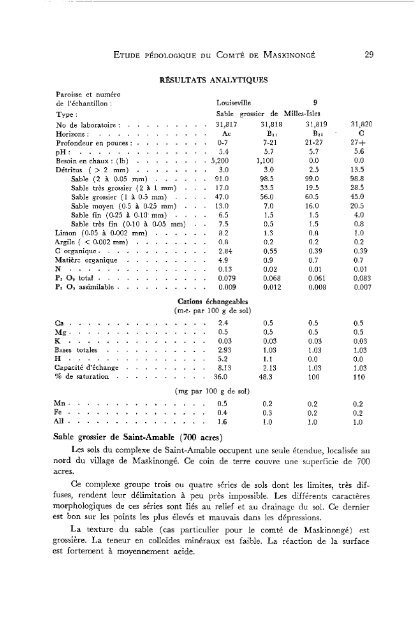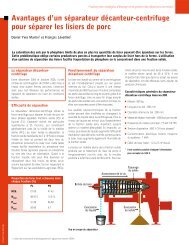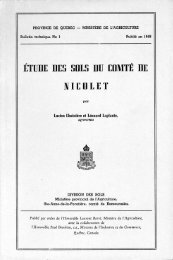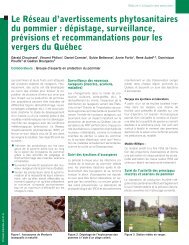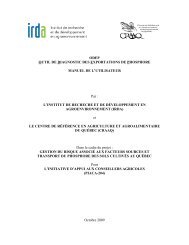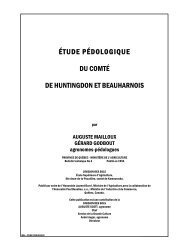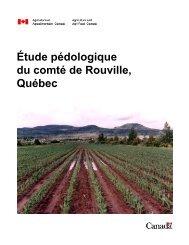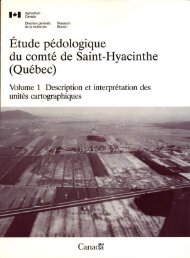PQ36 Étude pédologique du comté de Maskinongé - IRDA
PQ36 Étude pédologique du comté de Maskinongé - IRDA
PQ36 Étude pédologique du comté de Maskinongé - IRDA
Create successful ePaper yourself
Turn your PDF publications into a flip-book with our unique Google optimized e-Paper software.
ETUDE PÉDOLOGIQUE DU COMTÉ DE MASKINON& 29<br />
RESULTATS ANALYTIQUES<br />
Paroisse et numéro<br />
<strong>de</strong> l'échantillon : Louiseville 9<br />
Type : Sable grossier <strong>de</strong> Milles-Isles<br />
No <strong>de</strong> laboratoire: ......... 31. 817 31. 818 31. 819 31. 820<br />
Horizons: . . . . . . . . . . . . AC B2 BPI C<br />
Profon<strong>de</strong>ur en pouces: ........ 0-7 7-2 1 21-27 27+<br />
pH: . . . . . . . . . . . . . . 5.4 5.7 5.7 5.6<br />
Besoin en chaux : (Ib) . . . . . . . . 5. 200 1. 100 0.0 0.0<br />
Détritus ( > 2 mm) ........ 3.0 3.0 2.5 13.5<br />
Sable (2 à 0.05 mm) . . . . . . 91.0 98.5 99.0 98.8<br />
Sable très grossier (2 à 1 mm) . . . 17.0 33.5 19.5 28.5<br />
Sable grossier (1 à 0.5 mm) . . . . 47.0 56.0 60.5 45.0<br />
Sable moyen (0.5 à 0.25 mm) . . . 13.0 7.0 16.0 20.5<br />
Sable fin (0.25 à 0.10. mm) . . . . 6.5 1.5 1.5 4.0<br />
Sable très fin (0.10 à 0.05 mm) . . 7.5 0.5 1.5 0.8<br />
Limon (0.05 à 0.002 mm) . . . . . . 8.2 1.3 0.8 1.0<br />
Argile ( < 0.002 mm) . . . . . . . . 0.8 0.2 0.2 0.2<br />
C organique . . . . . . . . . . . . 2.84 0.55 0.39 0.39<br />
Matière organique . . . . . . . . . 4.9 0.9 0.7 0.7<br />
...............<br />
N 0.13 0.02 0.01 0.01<br />
P2 O, total . . . . . . . . . . . . 0.079 0.068 0.061 0.083<br />
P2 0 5 assimilable . ......... 0.009 0.012 0.008 0.007<br />
...............<br />
. . . . . . . . . . . . . . .<br />
...............<br />
Cations échangeables<br />
(me . par 100 g <strong>de</strong> sol)<br />
Ca 2.4 0.5 0.5 0.5<br />
Mg 0.5<br />
K 0.03<br />
Bases totales ........... 2.93<br />
H . . . . . . . . . . . . . . . 5.2<br />
Capacité d'échange 8.1 3<br />
0.5<br />
0.03<br />
1 . 03<br />
1.1<br />
2.13<br />
0.5<br />
0.03<br />
1 . 03<br />
0.0<br />
1 . 03<br />
0.5<br />
0.03<br />
1.03<br />
0.0<br />
1. 03<br />
.........<br />
% <strong>de</strong> saturation . . . . . . . . . . 36.0 48.3 1 O0 110<br />
. . . . . . . . . . . . . . .<br />
. . . . . . . . . . . . . . .<br />
...............<br />
(mg par 100 g <strong>de</strong> sol)<br />
Mn 0.5 0.2 0.2 0.2<br />
Fe 0.4 0.3 0.2 0.2<br />
Al1 1.6 1.0 1 .O 1.0<br />
Sable grossier <strong>de</strong> Saint-Amable (700 acres)<br />
Les sols <strong>du</strong> complexe <strong>de</strong> Saint-Am.able occupent une seule éten<strong>du</strong>e, localisée au<br />
nord <strong>du</strong> village <strong>de</strong> <strong>Maskinongé</strong> . Ce coin <strong>de</strong> terre couvre une superficie <strong>de</strong> 700<br />
acres .<br />
Ce complexe groupe trois ou quatre séries <strong>de</strong> sols dont les limites, très dif-<br />
fuses, ren<strong>de</strong>nt leur délimitation à peu près impossible . Les différents caractères<br />
morphologiques <strong>de</strong> ces séries sont liés au relief et au drainage <strong>du</strong> sol . Ce <strong>de</strong>rnier<br />
est bon sur les points les plus élevés et mauvais dans les dépressions .<br />
La texture <strong>du</strong> sable (cas particulier pour le <strong>comté</strong> <strong>de</strong> <strong>Maskinongé</strong>) est<br />
grossière . La teneur en colloï<strong>de</strong>s minéraux est faible . La réaction <strong>de</strong> la surface<br />
est fortement à moyennement aci<strong>de</strong> .


